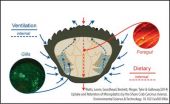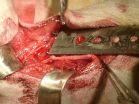(Press-News.org) BOSTON – Aspirin is the gold standard for antiplatelet therapy and a daily low-dose aspirin is widely prescribed for the prevention of cardiovascular disease.
Now, a new study suggests that common genetic variation in the gene for catechol-O-methyltransferase (COMT) may modify the cardiovascular benefit of aspirin, and in some people, may confer slight harm. The findings, led by investigators at Beth Israel Deaconess Medical Center (BIDMC) and Brigham and Women's Hospital (BWH) appear online in the American Heart Association journal Arteriosclerosis, Thrombosis, and Vascular Biology.
"This is one of the few cases where you can identify a single genetic polymorphism which has a significant interaction with aspirin such that it affects whether or not it protects against cardiovascular disease," says first author Kathryn Hall, PhD, MPH, an investigator in the Division of General Medicine and Primary Care at BIDMC and Research Fellow at Harvard Medical School.
COMT is a key enzyme in the metabolism of catecholamines, a group of hormones that include epinephrine, norepinephrine, and dopamine. "These hormones are implicated in a broad spectrum of disorders, including hypertension," explains Hall, "We were initially interested in finding out if the COMT gene affected people's susceptibility to incident cardiovascular disease such as myocardial infarction or ischemic stroke." Knowing that aspirin is commonly prescribed for the prevention of incident cardiovascular disease, the investigators also wanted to learn if genetic variation in COMT would influence aspirin's potential benefit.
To answer these questions, the researchers used data from the Women's Genome Health Study, a cohort of over 23,000 women who were followed for 10 years in a randomized double-blind, placebo-controlled trial of low-dose aspirin or vitamin E for the primary prevention of incident cardiovascular disease. Their analysis focused on val158met, a common variant in the COMT gene: Individuals who are homozygous for the enzyme's high-activity valine form, the "val/vals," have been shown to have lower levels of catecholamines compared to individuals who are homozygous for the enzyme's low-activity methionine form, the "met/mets,". The val/met heterozygotes are in between.
"When we examined women in the placebo arm of the trial, we found that the 23 percent of the women who were 'val/vals' were naturally protected against incident cardiovascular disease," explains senior author Daniel I. Chasman, PhD, a genetic epidemiologist in the Division of Preventive Medicine at Brigham and Women's Hospital and Associate Professor of Medicine at Harvard Medical School. "This finding, which was replicated in two other population-based studies, was in itself of significant interest." But, he adds, the investigation further revealed the surprising discovery that when the women with the val/val polymorphism were allocated to aspirin, this natural protection was eliminated.
"As we continued to look at the effects of drug allocation, we found that val/val women who were randomly assigned to aspirin had more cardiovascular events than the val/vals who were assigned to placebo," says Chasman. Among the 28 percent of women who were met/met, the opposite was true, and these women had fewer cardiovascular events when assigned to aspirin compared to placebo. The benefit of aspirin compared to placebo allocation for met/mets amounted to reduction of one case of incident cardiovascular disease for 91 treated women over 10 years of study follow-up. By contrast, the harm of aspirin compared to placebo allocation for the val/val women was an increase of one case per 91 treated.
The researchers further found that rates of cardiovascular disease were also reduced in met/met women assigned to vitamin E compared to those assigned to placebo.
The authors stress that the findings will require further research and replication to understand their potential for clinical impact. Nonetheless they note that given that aspirin is preventively prescribed to millions of individuals and the COMT genetic variant is extremely common, this study underscores the potential importance of individualizing therapies based on genetic profiles.
"What this study suggests is that we can be smarter about the groups of patients that would most likely benefit from aspirin," says study coauthor Joseph Loscalzo, MD, PhD, Chairman of the Department of Medicine and Physician-in-Chief at BWH. "Rather than give aspirin to all patients with risk factors for heart disease, we need to use modern genomics and genetics to identify those individuals for whom aspirin has the greatest benefit and the lowest risk of adverse effects."
One possible reason for the val/val protection could lie in COMT's role in the breakdown of epinephrine, the "fight or flight" hormone which is tightly linked to regulation of the cardiovascular system.
"When epinephrine levels rise in response to stress, blood pressure goes up and high blood pressure is a precursor to heart disease," explains Hall. "One possibility is that val/val individuals have less epinephrine than met/met individuals because their COMT is more efficient at breaking it down. This might help to naturally protect them against cardiovascular disease – that's our working hypothesis. It's harder to explain why the effect is modified by aspirin and that's what we're in the lab aggressively trying to figure out."
INFORMATION:
In addition to Hall, Chasman and Loscalzo, coauthors include Roger B. Davis, Irving Kirsch, Ted J. Kaptchuk and Murray Mittleman from BIDMC; Julie E. Buring and Paul M Ridker from BWH; and Christopher P. Nelson and Nilesh J. Samani from the University of Leicester, UK.
The Women's Genome Health Study is supported by HL043851 and HL080467 from the National Heart, Lung, and Blood Institute and CA 047988 from the National Cancer Institute. This study was also supported by NIH grants from the National Center for Complementary and Alternative Medicine (T32A5000051; R01AT004662; K24AT004095; R21AT002860; 3R01AT004662-02S1.)
Beth Israel Deaconess Medical Center is a patient care, teaching and research affiliate of Harvard Medical School, and currently ranks third in National Institutes of Health funding among independent hospitals nationwide.
BIDMC is in the community with Beth Israel Deaconess Hospital-Milton, Beth Israel Deaconess Hospital-Needham, Beth Israel Deaconess Hospital-Plymouth, Anna Jaques Hospital, Cambridge Health Alliance, Lawrence General Hospital, Signature Health Care, Beth Israel Deaconess HealthCare, Community Care Alliance, and Atrius Health. BIDMC is also clinically affiliated with the Joslin Diabetes Center and Hebrew Senior Life and is a research partner of Dana-Farber/Harvard Cancer Center. BIDMC is the official hospital of the Boston Red Sox. For more information, visit http://www.bidmc.org.
Brigham and Women's Hospital (BWH) is a 793-bed nonprofit teaching affiliate of Harvard Medical School and a founding member of Partners HealthCare. BWH has more than 3.5 million annual patient visits, is the largest birthing center in Massachusetts and employs nearly 15,000 people. The Brigham's medical preeminence dates back to 1832, and today that rich history in clinical care is coupled with its national leadership in patient care, quality improvement and patient safety initiatives, and its dedication to research, innovation, community engagement and educating and training the next generation of health care professionals. Through investigation and discovery conducted at its Brigham Research Institute (BRI), BWH is an international leader in basic, clinical and translational research on human diseases, more than 1,000 physician-investigators and renowned biomedical scientists and faculty supported by nearly $650 million in funding. For the last 25 years, BWH ranked second in research funding from the National Institutes of Health (NIH) among independent hospitals. BWH continually pushes the boundaries of medicine, including building on its legacy in transplantation by performing a partial face transplant in 2009 and the nation's first full face transplant in 2011. BWH is also home to major landmark epidemiologic population studies, including the Nurses' and Physicians' Health Studies and the Women's Health Initiative. For more information, resources and to follow us on social media, please visit BWH's online newsroom.
Genetic variations may modify cardiovascular benefit of aspirin
2014-07-18
ELSE PRESS RELEASES FROM THIS DATE:
Microplastics worse for crabs and other marine life than previously thought, study shows
2014-07-18
The tiny plastic particles polluting our seas are not only orally ingested by marine creatures, but also enter their systems through their gills, according to a new study led by the University of Exeter.
Scientists also discovered that when microplastics are drawn in through this method they take over six times longer to leave the body compared with standard digestion.
Lead author Dr Andrew Watts of the University of Exeter said: "Many studies on microplastics only consider ingestion as a route of uptake into animals. The results we have just published stress other ...
The bend in the Appalachian mountain chain is finally explained
2014-07-18
The 1500 mile Appalachian mountain chain runs along a nearly straight line from Alabama to Newfoundland—except for a curious bend in Pennsylvania and New York State. Researchers from the College of New Jersey and the University of Rochester now know what caused that bend—a dense, underground block of rigid, volcanic rock forced the chain to shift eastward as it was forming millions of years ago.
According to Cindy Ebinger, a professor of earth and environmental sciences at the University of Rochester, scientists had previously known about the volcanic rock structure under ...
Immune cell's role in intestinal movement may lead to better understanding of IBS
2014-07-18
Learning the role of immune-system cells in healthy digestive tracts and how they interact with neighboring nerve cells may lead to new treatments for irritable bowel syndrome (IBS). Researchers from Penn State College of Medicine, in collaboration with other scientists, have reported the role of macrophages in regulating the contractions of the colon to push digested material through the digestive tract.
The muscular lining of the intestine contains a distinct kind of macrophage, an immune system cell that helps fight infections. The role of these cells in normal colon ...
It's go time for LUX-Zeplin dark matter experiment
2014-07-18
New Haven, Conn. -- From the physics labs at Yale University to the bottom of a played-out gold mine in South Dakota, a new generation of dark matter experiments is ready to commence.
The U.S. Department of Energy's Office of Science and the National Science Foundation recently gave the go-ahead to LUX-Zeplin (LZ), a key experiment in the hunt for dark matter, the invisible substance that may make up much of the universe. Daniel McKinsey, a professor of physics, leads a contingent of Yale scientists working on the project.
"We emerged from a very intense competition," ...
Improving driver safety: How to prevent streetlight glare in the new world of LED lighting
2014-07-18
WASHINGTON, July 18—Long hours of nighttime driving can cause eyestrain because while our vision adapts to the surrounding darkness, the sudden stabs of brightness from streetlamps can be irritating, distracting and even painful. Even as LED technology has transformed the lighting industry, bringing the promise of more energy-efficient road illumination, some fear that the new lights could cause even more troublesome, unsafe glare.
A team of researchers from China and the Netherlands has developed a way to evaluate the human impact of uncomfortable glare caused by LED ...
NASA sees super typhoon Rammasun eyeing landfall
2014-07-18
Imagery from NASA's Aqua satellite captured a wide-eyed Typhoon Rammasun as it was making landfall in northern Hainan Island, China early on July 18. A rainfall analysis using another NASA satellite showed the flooding potential of the storm as it left the Philippines and headed for China. Now, Rammasun is headed for a final landfall near the northeastern border of Vietnam and China.
On July 17, an analysis of Typhoon Rammasun's rainfall was conducted at NASA's Goddard Space Flight Center in Greenbelt, Maryland. The rainfall analysis covered the storm's rainfall from ...
NASA satellite catches birth of Tropical Storm Wali near Hawaii
2014-07-18
The first tropical cyclone of the season has formed in the Central Pacific Ocean as NASA's Terra satellite passed overhead. Tropical Storm Wali formed southeast of the Big Island of Hawaii, and now that it's nearing, a Flash Flood Watch has been posted for all of the islands.
NASA's Terra satellite passed over Wali on July 17 at 19:55 UTC (3:55 p.m. EDT) just as it was being classified as Tropical Depression 1C. NOAA's Central Pacific Hurricane Center (CPHC) issued an advisory at 5 p.m. EDT (11 a.m. HST) announcing the birth of the depression near 12.7 north and 140.7 ...
A rhesus monkey model of radial nerve injury for evaluating peripheral nerve repair
2014-07-18
Current research on bone marrow stem cell transplantation and autologous or xenogenic nerve transplantation for peripheral nerve regeneration has mainly focused on the repair of peripheral nerve defects in rodents. Dr. Dong Wang and his team, First Affiliated Hospital of Sun Yat-sen University, China established a standardized experimental model of 2.5 cm-long radial nerve defects in rhesus monkeys and evaluated the effect of repair on peripheral nerve injury. The quality of nerve regeneration in the bone marrow stem cells-laden allografts was comparable to that achieved ...
Intranasal nerve growth factor repairs injured spinal cord neurons
2014-07-18
Nerve growth factor can be delivered to the brain by intranasal administration without risk for treatment of brain diseases. Dr. Luigi Aloe, Cellular Biology and Neurobiology Institute, National Research Council, Italy and his team performed a study to investigate whether, by intranasal administration, the nerve growth factor bypasses the blood-brain barrier and turns over the spinal cord neurons. Results showed that at 3 weeks after intranasal administration of nerve growth factor, the contents of nerve growth factor and its receptor in the spinal cord were increased, ...
How does L-carnitine maintain the normal structure of sciatic nerve in crush injury?
2014-07-18
Several studies have demonstrated that L-carnitine exhibits neuroprotective effects on injured sciatic nerve of rats with diabetes mellitus. Dr. Ümmü Zeynep Avsar, Faculty of Medicine, Ataturk University, Turkey and his team proposed a hypothesis that L-carnitine exhibits neuroprotective effects on injured sciatic nerve of rats. Rat sciatic nerve was crush injured by a forceps and exhibited degenerative changes. After intragastric administration of 50 and 100 mg/kg L-carnitine for 30 days, axon area, myelin sheath area, axon diameter, myelin sheath diameter, and numerical ...





